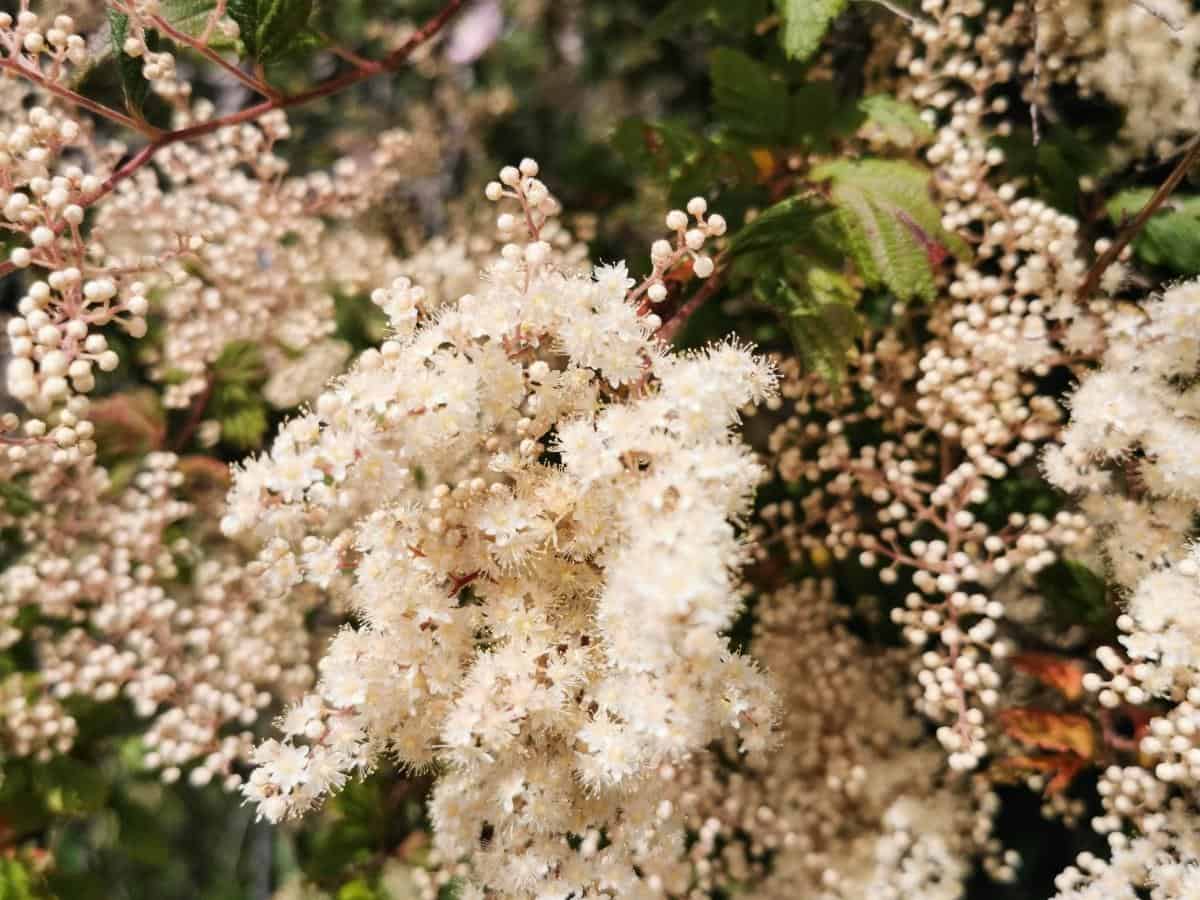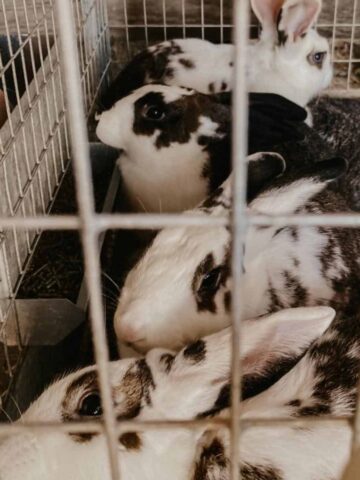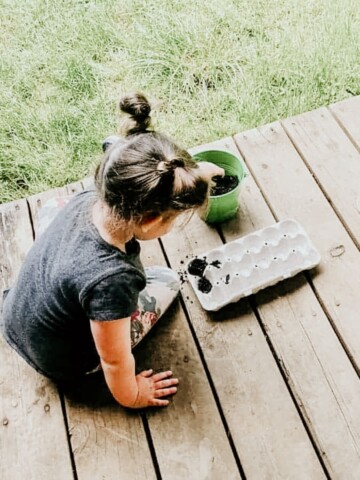
"We cannot really approach the truth about our world without feeling how our identities are intimately woven into place, without truly being our place, in every way...Learning from place becomes rooted in everything that is around us through experience, extending in every direction - and ultimately beyond what we know as 'direction.' 'Who has been here, and who will come? What is the essence, or spirit, of our place?' If we begin to see ourselves as not just rooted in the ground, but also deeply connected to everything around us, everything changes, including how we feel, think, and behave."
- Natural Curiosity, 2nd Edition
Welcome! Today, we are sharing our contribution to The Montessori Earth Project. Our project is a long-term undertaking of building a native forest garden on the farm where we live. We came up with our project idea together as a family as it meshed well with our current studies and we are excited to share our progress with you.
Disclosure of Material Connection: Some of the links in the post are “affiliate links.” This means if you click on the link and purchase the item, I will receive an affiliate commission. Amazon links are not affiliate links. You can read my full affiliate disclosure.
What is a Forest Garden?
A forest garden, or food forest, is a forest consisting of trees, shrubs, and plants that are edible for humans as well as wildlife. We are building a native forest garden, meaning the species are naturally occurring in our area.
Creating a forest garden is a great way to support your local ecosystem. It's a healthy, sustainable food resource for humans and other species. In fact, the water, soil, and wildlife all reap the benefits of a well-planned forest garden.
What is The Earth Project?
The Earth Project is a global project via Montessori Everywhere that aims to connect Montessori schools and families together in a collaborative effort to save the planet. It is one of several resources from our Primary Curriculum and Elementary Curriculum that we value for its ability to encourage a lasting connection with nature.
With the goal of regenerating Mother Earth, we came up with our forest garden project and spent several months putting our plan into action. Here, we are sharing what we've accomplished so far and where we're headed in the future.
What Do You Plant in a Forest Garden?
Well, that is going to depend on where you live. We have been incorporating Indigenous and other local resources into the planning and design of our native forest garden, as you will see. We are learning so much through this process and having the wisdom of those more experienced in this subject matter to guide us has really propelled us forward where we may have otherwise stalled.
How Do You Plan a Forest Garden?
For us, the steps included:
- Learning about the land and its people
- Learning directions using a compass
- Creating a map
- Designing the Native Forest Garden
- Sourcing plants and materials
- Creating a planting and maintenance schedule
- Planting
- Documenting our work
Throughout this process, we encouraged participation by our kids through prompts, invitations to participate, stories, and more. From learning about the area, to creating the map and choosing the plants, our kids played a big role in this project. As parents, we assisted with the larger tasks and included our kids as much as possible along the way.

Building a Native Forest Garden with The Earth Project
In coming up with a project that would allow us to explore the concept of regenerating the Earth, it quickly became apparent to us that we needed to learn more about this land that we are guests on. More specifically, we wanted to explore our understanding of the farm where we live and its inhabitants. This would be critical to building a relationship of reciprocity with the land. Therefore, this is where our Montessori Earth Project journey began.

Learning About the Land
This is the location on the farm where we will be starting the forest garden. The area to the left of the fence begins the forest where we will be planting. It continues further back and to the left than what you see in the image.
We've spent a lot of time in this area just experiencing what is already here. Our goal was to identify what is existing in this spot, including any invasive species. As you can see, it's mostly oak trees and grass. There are some maple trees as well as fruit and nut trees a bit further away.
No invasive species were found here. However, it did occur to us while planning this project that our presence on this land has the potential to thrust us into the role of what would normally be considered an invasive species. Having the freedom to do or not do what we want with this space can have a negative effect on this ecosystem. It's something that was not lost on us as newcomers to this property and guests of the land.
You may already know we spent some time during our Fourth Great Lesson exploring Indigenous languages and cultures of the Pacific Northwest. That work was taking place at the same time we were planning our food forest and it was nice to be able to have the experience of joining it all together through The Earth Project.
We learned about many native species of plants through the Noble Oaks series by the Grande Ronde Cultural Education Program. We all really enjoyed watching this series and having the opportunity to learn about the land from the Confederated Tribes of Grande Ronde.

Learning Cardinal Directions
Also covered in our Fourth Great Lesson was the experience of learning about Cardinal Directions. We used this Mirus Toys Compass Rose Puzzle and the included Nomenclature Cards along with a compass to practice identifying directions in preparation for mapmaking.

Creating a Map of the Land
Our kids created a map of the farm, including deer, coyote, trees, our vegetable garden, grapes, apples, salmon, turkey, and elk. Having a visual representation of everything that lives here and where it's located was really helpful for identifying what we should include in our forest garden.
The chinook salmon you see on our map are from this Chinook Salmon Unit Study our kids completed earlier in the school year.

We also spent a lot of time checking out the neighbor's trees on his tree farm.

Designing the Native Forest Garden
We're using this Old-Fashioned on Purpose Planner for our forest garden. It has a very helpful layout for any growing, harvesting, or cooking projects we do. Currently, we're in the process of sketching our layout, having recently located native plants for sale, and we can share that in our next update.

Sourcing Native Plants and Materials
As of publishing this, we have just purchased some native plants through Yamhill Soil and Water Conservation District's native plant sale. Our oldest helped pick them out and I think we chose a nice variety that will benefit all. If you're looking to take on a project like this, I would recommend contacting your local Soil and Water Conservation District or your local Watershed Council.
Our forest garden will include:
- 12 Great Camas Potted Plants (pictured at the top)
- 4 Common Yarrow Potted Plants
- 6 Kinnikinnick Potted Plants (pictured above with red berries)
- 12 Nootka Rose Bareroot Shrubs
- 4 Oceanspray Bareroot Shrubs (pictured above with white flowers)
- 4 Salmonberry Bareroot Shrubs
- 2 Native Pollinator Seed Packets
- Yampah Seeds
- Narrowleaf Onion Seeds
- 4 Noble Fir Trees
This is a great starting point for us. All of these plants are of cultural significance to the Indigenous peoples of this area, whether it be food, medicine, or ceremonial uses. As a matter of fact, we actually went back and ordered the oceanspray after learning about their use for making youth arrows in Trees & Forests of Mary's Peak: The Stories They Tell.
We are learning about all the traditional uses of these plants now and can add that information into our next update as well.

What's Next?
Here's what our upcoming list of tasks includes:
- Picking up the plants and additional supplies
- Determining planting and maintenance schedule & add to our daily/weekly rhythms
- Planting forest garden
- Documenting our work
The plants will be ready for pick-up in February. Until then, we will be outside observing, listening, playing, and using our imaginations to envision what's to come. You can find our tips for gardening with kids in Montessori Gardening: Empower Kids to Grow Their Own Food & Eat Healthy.
Conclusion for Building a Native Forest Garden
We hope you enjoyed seeing what we've been working on with the Montessori Earth Project. It's been a fun activity and we've learned so much along the way about ourselves, the community we call home, and Mother Earth. We look forward to continuing our work and sharing this story.
Our next update will hopefully include more of the fun hands-on experiences our kids are most excited for. Until then, we hope you find this useful for any forest garden projects of your own.
More Forest Garden and Nature Connection Resources
- Soil Composition Test & Sediment Jars
- Caring for Rabbits
- Making Relatives
- How to Raise a Wild Child
- Wings, Worms, and Wonder
- Nature's Headdresses
Thanks for stopping by.
- Kristin
Building a Native Forest Garden

Learn how to build a forest garden of native plant species using Indigenous and other local resources. We started this endeavor as part of the Montessori Earth Project. After growing a thriving forest garden, this opens up opportunities for additional learning such as nature journaling, seed saving, harvesting, preserving, meal preparation, and other traditional uses of plant materials. Kids may need assistance with coordinating the activities for this project.
Materials
- Indigenous & Other Local Resources for your Location
- Mirus Toys Compass Rose Puzzle
- Compass
- Cardboard or Construction Paper
- Colored Pencils
- Planner
- Native Plants and Seeds
Tools
- Gardening Tools
Instructions
- Learn About the Land and its People. Investigate the history of your location, learn about Indigenous peoples, languages, and cultures. Identify any native and invasive plant species present in your desired planting location.
- Learn Directions Using a Compass. Use the Compass Rose Puzzle and Compass to learn cardinal directions. This will enhance understanding of maps and location.
- Create a Map. Kids can use cardboard or construction paper and colored pencils to create a map of the area where you live.
- Design the Native Forest Garden. Use information about the plant species to determine a design for the forest garden. If you don't know ahead of time what you will be planting, this may wait until you have sourced your planting materials.
- Source Plants and Materials. Locate and purchase native plants or seeds. Your local soil and water conservation district or watershed should be able to assist as needed. Include kids in the process as much as they show interest.
- Create a Planting and Maintenance Schedule. This will be determined by what you are planting, your location, and other factors.
- Plant your trees, shrubs, and/or seeds according to your design. Encourage kids to participate by providing appropriate tools for their size and ability.
- Document Your Work. Record your activities for future reference.
Notes
Full Lesson Info and Pictures at: https://happyhomeschooladventures.com/forest-garden/
Recommended Products
As a member of affiliate programs, I earn from qualifying purchases, at no cost to you.






Leave a Reply